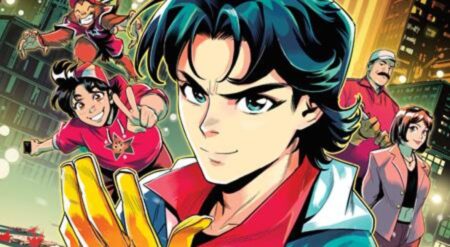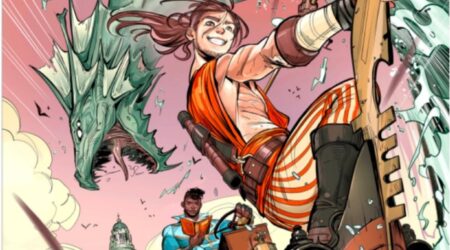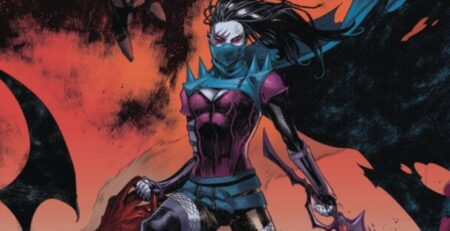
Dudley Datson and the Forever Machine #2 is written by Scott Snyder, penciled by Jamal Igle, inked by Juan Castro, colored by Chris Sotomayor, and lettered by Tom Napolitano. It’s published by ComiXology under Snyder’s Best Jackett Press imprint. Dudley Datson has been swept up into a web of murder and mystery, as he’s being pursued by the Needle’s Eye and their superhuman agents the Prometheans. Luckily he has help from a talking dog named Daedalus, who knows their pursuers inside and out. Daedalus takes Dudley to a secret location, where he tells him about his connection to the inventor of the same name – as well as the origins of the Needle’s Eye.
Though it’s only two issues in, Dudley Datson is a major example of what’s made Snyder such an intriguing writer to follow. When you crack open a Scott Snyder comic, there are enough twists and turns for a pretzel stand as well as some Big Concepts that boil down to a simple theme: choice. From his work on Batman to his creator-owned work including We Have Demons and Undiscovered Country, the choices that protagonists and antagonists make shape their worlds as well as their outlooks on life. This comic is no different; the choice of one man to create the device known as the Forever Machine led to a conflict that spanned centuries and pitted those who want to help mankind against those who care only for their own selfish interests.
Snyder also has a habit of finding insanely talented artists to work with, and Igle is no exception. He takes the chance to fill each and every page with jaw-dropping imagery. When Dudley and Daedalus arrive in their secret location, it’s filled wall to wall with some of the greatest inventions in human history—including the airplane and the printing press. Igle also makes the Prometheans every bit as frightening as Daedalus describes them; blue energy wraps around their stony bodies, and none of them have a face.
But the standout sequence takes place in the middle of the book, which contains a flashback to the origins of the Forever Machine. Castro and Sotomayor work to make the images look like faded photographs, complete with wrinkles and graying white patches. A dark blue hue also covers the majority of the images, giving off a sense of foreboding before all hell breaks loose. In contrast, the present-day sequences have a lighter palette, with red and blue being the prominent colors. And finally, Napolitano gives Daedaleus his own distinct style of speech that’s scratchy and angular, which is weirdly how I’d expect a talking dog to sound.
Dudley Datson and the Forever Machine #2 leans into the scope of its concept, as its creative team crafts a story that rivals more than a few young adult franchises. We live in a time where there are plenty of comics shaking up their respective publishers and genres, and Dudley Datson is a key example of this. If I can paraphrase a line from Daedalus, Snyder and Igle aren’t afraid to think big when it comes to this series.
Dudley Datson and the Forever Machine #2 is available to read via ComiXology.
Dudley Datson and the Forever Machine #2
TL;DR
Dudley Datson and the Forever Machine #2 leans into the scope of its concept, as its creative team crafts a story that rivals more than a few young adult franchises. We live in a time where there are plenty of comics shaking up their respective publishers and genres, and Dudley Datson is a key example of this. If I can paraphrase a line from Daedalus, Snyder and Igle aren’t afraid to think big when it comes to this series.







